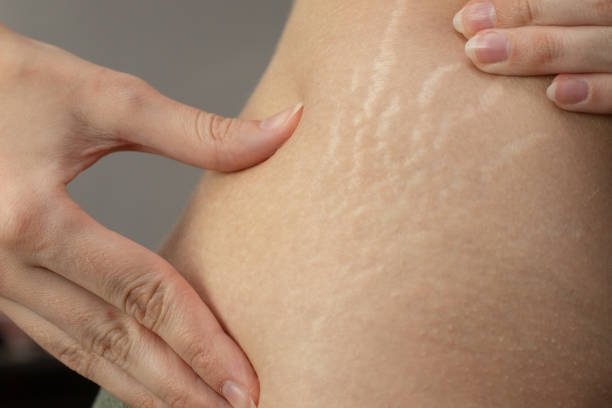Key Differences Between Cellulite and Stretch Marks: A Comprehensive Guide

🔍 Get the Lowdown on Cellulite vs Stretch Marks! ✔️ Our comprehensive guide clears up the confusion. Understand the key differences now! 🧐👏
Cellulite and Stretch Marks
Cellulite refers to the dimpling of skin caused by fat deposits beneath, often appearing on the thighs and buttocks. Stretch marks are scars formed when the skin rapidly stretches, leading to discolored lines on various body areas. To gain a clearer understanding, exploring the Difference between Cellulite and Stretch Mark can help highlight their unique causes, appearances, and potential treatments, making it easier to address each condition effectively.
Illustration of How Cellulite Appears
Cellulite manifests as a dimpled, uneven texture on the skin’s surface, often resembling an orange peel. It develops when fat deposits push through connective tissue, creating an irregular appearance predominantly on the thighs and buttocks.
Various Stages of Cellulite
Cellulite develops in distinct stages, starting from the initial appearance of minor dimpling to more pronounced texture changes. Gradually, it can lead to deeper indentations and a firmer consistency within the affected areas.
Cellulite on Self-Esteem
Cellulite can significantly affect a person’s self-esteem, as visible skin dimpling often leads to feelings of insecurity and self-consciousness. Many individuals may struggle with body image issues as a result.
Stages of Stretch Mark Development
Stretch marks develop through several stages. Initially, they appear as red or purple streaks due to skin expansion. Over time, these marks fade to a lighter hue and become less noticeable but remain permanent.
How Stretch Marks Affect Body Image
Stretch marks can significantly impact an individual’s body image, often leading to feelings of insecurity and self-consciousness. Many people perceive these marks as imperfections, negatively influencing their confidence and overall self-esteem.
Differences in Appearance
Cellulite appears as a lumpy, dimpled texture, while stretch marks manifest as lines or streaks that can vary in colour.
Differences in Causes
Cellulite is caused by fat deposits pushing through the skin’s connective tissue, while stretch marks result from rapid skin stretching due to pregnancy, weight changes, or growth spurts.
Development Process
Cellulite forms when the fat beneath the skin is trapped, whereas stretch marks occur when the skin is overstretched and loses its elasticity.
Differences in Treatment
Cellulite treatment typically focuses on reducing its appearance through massage, creams, or laser treatments. Stretch marks, on the other hand, are often treated with topical creams, microdermabrasion, or laser therapy.
Common Misconceptions
People often hold incorrect or oversimplified beliefs about cellulite and stretch marks, leading to widespread misunderstanding.
Ascertain the Truth
It’s important to evaluate evidence and consider different perspectives to distinguish fact from fiction, allowing for a clearer understanding of the situation.
Medical Treatments
Medical treatments encompass various procedures and therapies designed to prevent, manage, or reduce cellulite, including pharmaceutical drugs, surgeries, and laser therapies.
At-Home Remedies
Home remedies offer simple, natural solutions for reducing cellulite, such as dry brushing or the use of essential oils. These approaches are often cost-effective and accessible.
Lifestyle Changes for Prevention
Adopting healthier lifestyle changes is crucial for preventing cellulite. This includes regular exercise, balanced nutrition, adequate sleep, stress management, and avoiding harmful habits like smoking or excessive drinking.
Medical Treatments
Medical treatments for stretch marks include laser therapy, topical treatments, and microdermabrasion, which can help reduce the visibility of the marks over time.
At-Home Remedies
Natural treatments for stretch marks include the use of oils like coconut oil, cocoa butter, and vitamin E to moisturize the skin and improve its elasticity.
Preventions
Preventive measures for stretch marks include maintaining a healthy weight, staying hydrated, and using creams that enhance skin elasticity during pregnancy or periods of rapid growth.
Common Causes of Cellulite and Stretch Marks
Both cellulite and stretch marks are influenced by various factors, although they have distinct causes. Understanding these causes can help individuals manage and even prevent their appearance.
Cellulite Causes:
- Hormonal Changes: Hormones play a significant role in the formation of cellulite. Estrogen, the primary female hormone, contributes to fat storage and affects connective tissue. Hormonal fluctuations, particularly during puberty, pregnancy, or menopause, may cause an increase in cellulite.
- Genetics: Genetics is another major contributor to the development of cellulite. Some people are more genetically predisposed to have a higher percentage of body fat or weaker connective tissue, which makes them more likely to experience cellulite.
- Diet and Lifestyle: A poor diet, high in fats, carbohydrates, and salt, can contribute to cellulite. These foods encourage fat storage and reduce the skin’s elasticity, exacerbating the dimpled appearance of cellulite. A sedentary lifestyle or lack of exercise can also result in the accumulation of fat, further promoting the development of cellulite.
Stretch Marks Causes:
- Rapid Weight Gain or Loss: Stretch marks are commonly associated with significant weight changes. This could be due to pregnancy, puberty, or rapid weight gain from muscle building or overeating. The skin is stretched too quickly, causing the underlying tissues to rupture and form scars.
- Genetics: Like cellulite, stretch marks can also run in families. If your parents had stretch marks, you may likely develop them as well, especially during periods of rapid growth or hormonal changes.
- Hormonal Changes: The hormonal changes that occur during pregnancy, puberty, or the use of corticosteroid medications can weaken the skin’s collagen and elastin fibres, making it more prone to stretch marks. Corticosteroids, in particular, can reduce skin elasticity, contributing to the formation of these marks.
Psychological Impact of Cellulite and Stretch Marks
The Emotional Toll of Cellulite:
Many individuals with cellulite feel self-conscious about their appearance, especially in settings where the skin is exposed, such as at the beach or while wearing summer clothes. This feeling can lead to body image issues and reduced self-esteem. It’s essential to recognise that cellulite is a common condition, affecting a wide range of body types, and is not an indicator of poor health.
While cellulite treatments may improve its appearance, managing its emotional impact can also involve fostering a positive body image. People should remember that cellulite does not define their worth, and embracing body diversity is key to overcoming insecurities.
The Psychological Effect of Stretch Marks:
Similarly, stretch marks can cause emotional distress, especially in individuals who associate them with a negative self-image. They are often considered signs of aging, weight gain, or pregnancy, which can trigger feelings of embarrassment or self-consciousness.
However, just like cellulite, stretch marks are a natural part of the body’s growth and change process. Recognizing that stretch marks are common among people of all shapes and sizes can help reduce the stigma associated with them. Fostering a mindset of acceptance and self-love can mitigate the emotional toll of stretch marks.
Proactive Measures for Preventing Cellulite and Stretch Marks
While some factors contributing to cellulite and stretch marks may be out of our control, adopting a proactive approach to skin health can minimize their development.
Prevention Tips for Cellulite:
- Exercise Regularly: Strength training exercises, particularly those that target the lower body, such as squats and lunges, can help tone muscles and reduce the appearance of cellulite by tightening the skin.
- Maintain a Healthy Weight: Avoid drastic weight fluctuations, as they can strain the skin. Opt for gradual and consistent weight management practices.
- Hydration and Nutrition: Drinking plenty of water keeps the skin hydrated and improves its elasticity. Consuming a diet rich in antioxidants, vitamins, and omega-3 fatty acids supports overall skin health.
Prevention Tips for Stretch Marks:
- Moisturize the Skin: Regularly moisturizing the skin with lotions or oils helps keep it supple and elastic, reducing the likelihood of stretch marks. Products containing ingredients like hyaluronic acid and collagen may improve the skin’s ability to stretch without forming marks.
- Control Weight Gain: Preventing rapid weight gain or loss is a fundamental step in reducing the risk of stretch marks. Slow, steady changes in weight are less likely to stretch the skin significantly.
- Support During Pregnancy: Pregnant women can apply specific creams or oils to areas prone to stretch marks, like the belly, thighs, and hips. These measures may help maintain skin elasticity during the stretching process.



